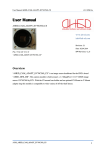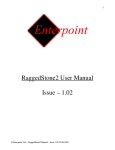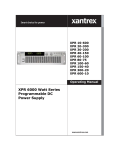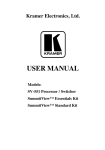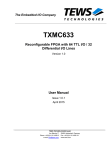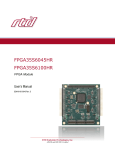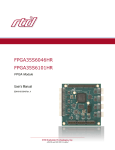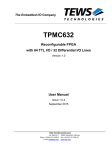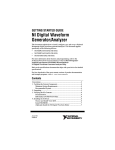Download User Manual User Manual
Transcript
v2.1 020414a User Manual AHED_MFB_MB User Manual AHED_MFB_MB www.ah-ed.com [email protected] Revision: 2.1 Date: 02.04.2014 HW-Revision: v1_1 Fig.1. Top side view of AHED_MFB_MB Overview “AHED_MFB_MB” is a board designed around a Xilinx Spartan-6 LXT device in FGG484 package. It features one Gbit/s Ethernet PHY, two 100 Mbit/s Ethernet PHYs, two independent 16-bit wide DDR3 SDRAMs and a 32 Mbyte Quad-SPI Flash. In principle, all densities of the Spartan-6 LXT FPGA, beginning with the LXT25 up to the LXT150 can be assembled on the board. Expansion connectors are provided at bottom and top side. The top side expansion connectors include up to 4 lanes of the Multi Gigabit Transceivers MGTs ( for serial connectivity up to 3.2 Gbit/s ) with 3 of the dedicated differential clock inputs made available, as well. There is an additional FFC connector for attaching an optional Megapixel CMOS image sensor board “AHED_CAM_ADAPT_EV76C560_CS”. Up on request reference designs ( FPGA netlist + C-code ) for the on-board components can be made available by AHED. AUM_AHED_MFB_MB 1 User Manual AHED_MFB_MB v2.1 020414a Fig.2: Top side view next to bottom side view of “AHED_MFB_MB” Key Features - Spartan-6 LXT FPGA ( XC6SLX25T, XC6SLX45T, XC6SLX75T, XC6SLX100T or XC6SLX150T ) - Two (XC6SLX25T ) or four ( XC6SLX45T to XC6SLX150T ) MGT lanes are made available via the top side expansion connectors allowing for serial highspeed connectivity like PCI express, SATA, DisplayPort or High-Speed ADCs/DACs with JESD204 interface - 1x 10/100/1000 Mbit/s tri-speed Gigabit Ethernet PHY ( Marvell 88E1111 ), magnetics and RJ45 Jack onboard - 2x 10/100 Mbit/s Ethernet PHY ( SMSC LAN8720A ), magnetics and RJ45 Jacks onboard - 2x 16-bit wide 1Gbit ( 128 Mbyte ) DDR3 SDRAM - 1x Quad SPI NOR Flash 256Mbit ( 32 Mbyte ) - JTAG connector ( with included adapter compatible to standard Xilinx JTAG cable ) - For XC6SLX75T, XC6SLX100T or XC6SLX150T bitstream encryption ( AES256 ) with onboard battery for volatile key in SRAM - Each Spartan-6 FPGA includes a unique 56-bit “Device-DNA” for unambiguously identifying a board. Apart from that the Spansion SPI flash features a One Time Programmable ( OTP ) array of 1024 bytes - Bottom side expansion connectors ( 2x FX8C-60P-SV6 ) • Hirose FX8-Series, up to 3.125 Gbit/s, in principle stacking heights from 5 mm to 16 mm ( in standard configuration 11 mm or 16 mm ) AUM_AHED_MFB_MB 2 User Manual AHED_MFB_MB • v2.1 020414a Power can be supplied to the board via this connectors ( 5 V +- 5%, abs max 5.5 V ) • The internal 3.3 V and 1.5 V supply rails are made available to any external HW • - Up to 31 differential pairs or up to 62 single ended signals Top side expansion connectors ( 2x FX8C-80S-SV5 ) • The pinning of both connectors is almost identical to allow them to be used for two separate extensions or jointly • Hirose FX8-Series, up to 3.125 Gbit/s, in principle stacking heights from 5 mm to 16 mm ( in standard configuration 10, 11, 12, 14, or 16 mm ) • The internal 2.5 V and 3.3 V supply rails are made available on each of the connectors to the external circuit • Up to two MGT lanes with reference clock input are made available on each of the two connectors • - Up to 30 differential pairs or up to 60 single ended general purpose signals Clocking • The board features a low jitter 125 MHz PCI express clock generator, a 25 MHz low jitter oscillator and a low-power 100 MHz MEMS oscillator all accessible by the FPGA. - Dedicated camera connector • The board includes a 34-pin FFC connector for attaching AHED camera modules • - (optional ) µSD socket - Required Power Supply: • 5V +- 5 %, abs max 5.5 V • Power consumption: ~ 2 – 15 W ( depending on the specific configuration/ FPGA design ) - Optional DVI input ( up to 1920 x1200 @ 60 Hz ) via top side extension module “AHED_AHMD_DRL_DVI_RX” - Optional DVI output ( up to 1920 x1200 @ 60 Hz ) via top side extension module AUM_AHED_MFB_MB 3 User Manual AHED_MFB_MB v2.1 020414a “AHED_AHMD_DRL_DVI_TX” - Optionally, up to 2 additional 10/100/1000 Mbit/s tri-speed Gigabit Ethernet interfaces via top side extension modules “AHED_AHMD_DRL_E1G_MIC” Applications - Video/Image-Processing, Camera Interface - Embedded System Design/ System-on-Chip ( SoC ) development - Industrial Control - Data Recorder/Grabber • - ( High-Speed- ADCs, Camera, DVI -> DDR3, Ethernet ) Data Player • DDR3, Ethernet -> High-Speed DACs, DVI Fig. 3: Sample Application: Video Processing ( DVI-RX and DVI-TX module attached ) Fig.4: Sample Application: Camera Interface AUM_AHED_MFB_MB 4 User Manual AHED_MFB_MB v2.1 020414a Table of Contents Overview .................................................................................................................................... 1 Key Features ............................................................................................................................... 2 Applications ............................................................................................................................... 4 1. Dimensions/Mechanics ....................................................................................................... 6 2. On-board Power Rails ......................................................................................................... 8 3. Components ........................................................................................................................ 9 3.1. DDR3 SDRAM Memory ................................................................................................ 9 3.2. Flash Memory ................................................................................................................. 9 3.3. Ethernet Interfaces ......................................................................................................... 10 4. Clocking ............................................................................................................................ 13 5. JTAG ................................................................................................................................. 13 6. Camera Interface ............................................................................................................... 14 7. µSD Connector.................................................................................................................. 16 8. Status LEDs ...................................................................................................................... 16 9. FPGA Bank Overview ...................................................................................................... 17 10. Expansion Connectors ................................................................................................... 18 10.1. Pin Types ................................................................................................................... 18 10.2. Explanation of Net Names ......................................................................................... 18 10.3. Bottom Side Expansion Connectors .......................................................................... 19 10.4. Top Side Expansion Connectors................................................................................ 22 11. Constraint File ............................................................................................................... 27 12. Thermal Behavior .......................................................................................................... 27 13. Environmental Conditions............................................................................................. 27 14. Errata ............................................................................................................................. 28 15. Important Information ................................................................................................... 28 16. Installation ..................................................................................................................... 28 17. Default Configurations .................................................................................................. 28 18. Options .......................................................................................................................... 29 Accessories ( must be ordered separately ) .............................................................................. 29 19. Legal Notices ................................................................................................................. 32 AUM_AHED_MFB_MB 5 User Manual AHED_MFB_MB v2.1 020414a 1. Dimensions/Mechanics - The actual board has a size of 100 x 60 mm - The RJ45 Jacks protrude ~ 3 mm beyond the actual PCB edge - With stacking heights of up to 16 mm the Hirose FX8 connectors allow for placing connectors like ( RJ45, D-Sub, BNC ( low profile ), DVI… ) below this board and allow placing a top side expansion board directly above this PCB - The board has 4 mounting holes with a nominal diameter of 3.2 mm - Apart from the expansion connectors and RJ45 Jacks the highest component on the top side is ~6 mm and ~3 mm on the bottom side. - The nominal board thickness of “AHED_MFB_MB” is 1.6 mm Fig.5: Top side drawing of “AHED_MFB_MB” AUM_AHED_MFB_MB 6 v2.1 020414a User Manual AHED_MFB_MB Fig.6: Bottom side drawing of “AHED_MFB_MB” Receptacle FX8C-**>S-SV FX8C-**>S-SV5 FX8C-**>P-SV 5 mm 10 mm FX8C-**>P-SV1 6 mm 11 mm FX8C-**>P-SV2 7 mm 12 mm FX8C-**>P-SV4 9 mm 14 mm FX8C-**>P-SV6 11 mm 16 mm Header Tab.1: Expansion connector stacking height matrix AUM_AHED_MFB_MB 7 User Manual AHED_MFB_MB v2.1 020414a 2. On-board Power Rails1 - 5V • external power supply rail • +-5 %, abs max 5.5 V, exceeding this ( even if only for short transients ) can destroy the SMPS ICs (!!!) • Needs external bulk capacitance ( e.g. Aluminium 470 µF, >= 10 V, close to the board ) • Can either be provided via the right bottom side expansion connector or via soldering a cable to two pads on the top side - 3.3 V • Internally generated via SMPS from 5V • 3A • Supplies FPGA bank 0 ( routed primarily to expansion connectors top ) and bank 2 and FPGA Vccaux - - - - 2.5 V • Internally generated via SMPS from 5V • 3A 1.5 V • Internally generated via SMPS from 5V • 3A • Supplies FPGA bank 1 and 3 ( DDR3 interface ) 1.2 V • Internally generated via SMPS from 5V • 5A • Supplies FPGA core and Ethernet PHY cores 1.2 V ( MGT ) • Internally generated via SMPS from 5V with passive post-filter • 3A 1 The given current is the rated current of the individual SMPS circuit. The allowed combined power supplied by all SMPS together might be significantly lower due to thermal limitations AUM_AHED_MFB_MB 8 v2.1 020414a User Manual AHED_MFB_MB 3. Components 3.1. DDR3 SDRAM Memory - The board features two 16-bit wide 1Gbit ( 128 Mbyte ) DDR3 SDRAM memory chips. - These chips are connected to the dedicated Memory Controller Blocks ( MCBs ) within the FPGA accessible via bank 1and 3. - For detailed pinning information please refer to the constraint file (*.ucf) 3.2. - Flash Memory This board is equipped with a 256 Mbit ( 32 Mbyte ) Quad SPI flash, typically a S25FL256S device by Spansion - In Quad Read DDR mode data transfer rates of up to 66 Mbyte/s can be achieved. - Up on request a sample bitstream and Windows application can be provided for writing bitstream and or processor code into the SPI flash via a UDP connection from a Windows PC Net FPGA Signal Standard Description Pin SPI_CONFIG_CS AA3 LVCMOS33 Chip select signal, active low SPI_CONFIG_CLK Y20 LVCMOS33 Clock signal from FPGA to SPI Flash SPI_CONFIG_MISO AA20 LVCMOS33 DQ1, in 1x mode from SPI Flash to FPGA SPI_CONFIG_MISO2 R13 LVCMOS33 WPn/VPP/DQ2, required for 4x interface SPI_CONFIG_MISO3 T14 LVCMOS33 HOLDn/DQ3, required for 4x interface SPI_CONFIG_MOSI AB20 LVCMOS33 DQ0, in 1x mode from FPGA to SPI flash Tab.2: SPI Flash signal connection AUM_AHED_MFB_MB 9 v2.1 020414a User Manual AHED_MFB_MB 3.3. Ethernet Interfaces 3.3.1. 1000 Mbit/s - Implemented via a Marvell Alaska Ethernet PHY chip ( 88E1111 ) - Attached in RGMII mode - PHY MII address: 0b10000 - Magnetics and RJ45 Jack on board -> ready to use, accessible via left RJ45 Jack - Up on request a reference design ( netlist + C-code ) attaching the PHY to a MAC and via DMA to a MicroBlaze soft-core processor can be provided Net FPGA Pin Signal Standard Description ETHER_Reset_out M7 LVCMOS15 with HW reset for Gigabit Ethernet external pull up to 3.3V PHY, active low LVCMOS33 MII interface ( shared for all 3 MDC AB19 on-board PHYs ) MDIO D3 LVCMOS33 MII interface ( shared for all 3 on-board PHYs ) EtherA_INTin K7 LVCMOS33 Interrupt from Gigabit Ethernet PHY EtherA_Data_out[0] T7 LVCMOS33 EtherA_Data_out[1] U6 LVCMOS33 EtherA_Data_out[2] W9 LVCMOS33 EtherA_Data_out[3] Y8 LVCMOS33 EtherA_Data_EN Y12 LVCMOS33 EtherA_CLK_out W12 LVCMOS33 EtherA_Data_in[0] D2 LVCMOS33 EtherA_Data_in[1] D1 LVCMOS33 EtherA_Data_in[2] F3 LVCMOS33 EtherA_Data_in[3] E4 LVCMOS33 EtherA_DV C1 LVCMOS33 EtherA_CLK_in Y13 LVCMOS33 RGMII TX clock RGMII RX clock Tab.3: Gigabit/s Ethernet signal connection AUM_AHED_MFB_MB 10 v2.1 020414a User Manual AHED_MFB_MB 3.3.2. 100 Mbit/s - Two interfaces ( A ) and ( B ) - Implemented via a SMSC Ethernet PHY chip ( LAN8720A ) - Attached in RMII mode - PHY MII address: 0b00000 ( A ), 0b00001 ( B ) - Magnetics and RJ45 Jacks on-board -> ready to use, accessible via right RJ45 Jack (A) and middle RJ45 Jack (B) - Up on request a reference design ( netlist + C-code ) attaching the PHYs to MACs and via DMA to a MicroBlaze soft-core processor can be provided Net FPGA Signal Standard Description LVCMOS33 Shared tnterrupt from both100 Mbit Pin E100_INT_n D21 PHYs E100_RST_n Y3 LVCMOS15 with HW reset for both 100 Mbit/s PHYs, external pull up to active low 3.3V E100_A_RX_CRS_DV N16 LVCMOS33 E100_A_RX_ER P16 LVCMOS33 E100_A_RX_Din[0] T20 LVCMOS33 E100_A_RX_Din[1] U19 LVCMOS33 E100_A_Clkout V17 LVCMOS33 50 MHz RMII clock generated by FPGA E100_A_TX_EN W18 LVCMOS33 E100_A_TX_Dout[0] Y17 LVCMOS33 E100_A_TX_Dout[1] U19 LVCMOS33 E100_B_RX_CRS_DV J16 LVCMOS33 E100_B_RX_ER J17 LVCMOS33 E100_B_RX_Din[0] M18 LVCMOS33 E100_B_RX_Din[1] M17 LVCMOS33 E100_B_Clkout U13 LVCMOS33 50 MHz RMII clock generated by FPGA E100_B_TX_EN AUM_AHED_MFB_MB U14 LVCMOS33 11 v2.1 020414a User Manual AHED_MFB_MB E100_B_TX_Dout[0] AA18 LVCMOS33 E100_B_TX_Dout[1] AB18 LVCMOS33 Tab.4: 100Mbit/s Ethernet signal connection 3.3.3. Extension - Modules Up to 2 additional 1000 Mbit/s Ethernet interfaces can be added via the top side expansion connectors ( see Gbit/s Ethernet module “AHED_AHMD_DRL_E1G_MIC” ) AUM_AHED_MFB_MB 12 v2.1 020414a User Manual AHED_MFB_MB 4. Clocking - The main clock source of this board is a low jitter PCI express clock generator, providing 125 MHz differentially to the FPGA2 - This clock signal is the basis for designs using the DDR3 SDRAM or the MGTs and can be used to derive clocks for internal processing by means of the PLLs within the Spartan-6 FPGA, as well - There is a separate low jitter 25 MHz clock oscillator on-board that provides a 25 MHz reference clock to the Gigabit Ethernet PHY, the FPGA and the Camera FFC header - A further low power MEMS 100 MHz oscillator is present on the board, as well Net FPGA Signal Standard Description Pin clk125_p T12 LVDS_33 clk125_n U12 LVDS_33 clk100 AB12 LVCMOS33 CLK_25FPGA AA12 LVCMOS33 Tab.5: FPGA clocking signal connection 5. JTAG - Due to space constraints the boards itself does only have a proprietary 6 pin JTAG header that connects to the JTAG interface of the Spartan-6 FPGA. However, a small adapter PCB is provided with this board ( as can be seen e.g. on Fig.7 ) that makes the JTAG interface mechanically compatible with the standard 14-pin Xilinx download cable. - A soon as top side extension modules are installed the JTAG header might not be directly accessible anymore. Up on request AHED can provide simple adapter PCBs that keep the JTAG interface accessible with top side extension modules installed. - 2 The 88E1111 is not included in the JTAG chain on this board By changing two resistors on the board this frequency could be changed to 25 MHz, 100 MHz or 200 MHz AUM_AHED_MFB_MB 13 v2.1 020414a User Manual AHED_MFB_MB 6. Camera Interface - This board provides a dedicated interface for attaching camera modules by AHED. This interface can be found at the right side of the board ( as seen from the RJ45 Jacks ) in form of a 34-pin FFC connector. - Most of the pins of this interface are shared with the right bottom side expansion connector. So these are no longer available for general purpose use as soon as the camera interface is used - By means of the FFC cable the actual camera module/CMOS imager can be separated from the FPGA board by dozens of centimeters, as can be seen in Fig.7 - Up on request a reference design ( netlist + C-code ) attaching AHED’s camera module (“AHED_CAM_ADAPT_EV76C560_CS”) featuring an E2V 1.3 Megasample image sensor via DMA to a MicroBlaze soft-core processor working on the DDR3 memory can be provided. Net FPGA Pin Signal Standard3 Camera_Data_clk_A AB13 LVCMOS33 Camera_CSN_A C11 LVCMOS33 Description Chip select for the SPI configuration interface of the CMOS imager, active low Camera_reset_n AF24 LVCMOS15 with HW reset to the camera chip, active external pull up low to 1.8 V Camera_MOSI B8 LVCMOS33 Part of the SPI configuration interface of the CMOS imager Camera_SCK A8 LVCMOS33 Part of the SPI configuration interface of the CMOS imager Camera_MISO B23 LVCMOS18 Part of the SPI configuration interface of the CMOS imager Camera_TRIG_A A11 LVCMOS33 Camera_Data_A[0] R19 LVCMOS18 Camera_Data_A[1] R20 LVCMOS18 Camera_Data_A[2] T18 LVCMOS18 Camera_Data_A[3] T19 LVCMOS18 Camera_Data_A[4] U19 LVCMOS18 Trigger input for image acquisition 3 Those signals with LVCMOS33 go through a lefte shifter before being routed to the FFC connector to match the 1.8 V requirement of the image sensor AUM_AHED_MFB_MB 14 v2.1 020414a User Manual AHED_MFB_MB Camera_Data_A[5] V20 LVCMOS18 Camera_Data_A[6] T20 LVCMOS18 Camera_Data_A[7] U20 LVCMOS18 Camera_Data_A[8] U21 LVCMOS18 Camera_Data_A[9] U22 LVCMOS18 Camera_FEN_A T22 LVCMOS18 Data interface: Field enable signal Camera_LEN_A U23 LVCMOS18 Data interface: Line enable signal Camera_FLO_A U17 LVCMOS18 Illumination control output from the CMOS imager Tab.6: Camera connector signal connection Fig.7: Showing camera module “AHED_CAM_ADAPT_EV76C560_CS” with C Mount /CS Mount lens holder attached to the FPGA board AUM_AHED_MFB_MB 15 v2.1 020414a User Manual AHED_MFB_MB 7. µSD Connector - There is an optional µSD socket on the bottom side of this board. The connector is optional in the sense that it shares IOs with the left bottom side expansion connector and is deactivated ( by means of missing 0-Ohm resistors by default in favor of the bottom side expansion option ) - By adding eight 0402 0-Ohm resistors ( can be performed by AHED up on request ) the µSD socket can be made active - The µSD socket cannot be used for the XC6SLX75T device since the required IOs are not available on this device Net FPGA Pin Signal Standard Description SD_CLK W6 LVCMOS33 SD_DAT0 W8 LVCMOS33 SD_DAT1 V7 LVCMOS33 SD_DAT2 U8 LVCMOS33 SD_DAT3 T8 LVCMOS33 SD_CMD Y6 LVCMOS33 10k pull up to 3.3 V SD_SW_A V9 LVCMOS33 µSD-Connector switch A, 10k pull down SD_SW_B U9 LVCMOS33 µSD-Connector switch B, 10k pull up to 3.3 V Tab.7: µSD socket signal connection 8. Status LEDs - Each RJ45 Jack has 2 LEDs for indicating the status of the respective Ethernet interface. The specific behaviour depends on the configuration of the specific PHY - All further LED outputs of the Marvell 88E1111 Gigabit/s Ethernet PHY are connected to red SMD LEDs on the board - There are 3 LEDs indicating the status of the FPGA • “INIT_B”: Illuminates red while the FPGA is not configured • “DONE”: Illuminates green when the FPGA is configured • “AWAKE”: AUM_AHED_MFB_MB 16 User Manual AHED_MFB_MB v2.1 020414a 9. FPGA Bank Overview - - - - Bank 0: • “top” bank • Vccio: 3.3 V • True LVDS output capable • LVCMOS 3.3 V output capable Bank 1: • “right” bank • Vccio: 1.5 V • LVCMOS output only at 1.5 V • LVCMOS input up to 3.3 V Bank 2: • “bottom” bank • Vccio: 3.3 V • True LVDS output capable • LVCMOS 3.3 V output capable Bank 3: • “left” bank • Vccio: 1.5 V • LVCMOS output only at 1.5 V • LVCMOS input up to 3.3 V AUM_AHED_MFB_MB 17 User Manual AHED_MFB_MB v2.1 020414a 10. Expansion Connectors 10.1. Pin Types Type Description GND Ground pin PWR Power supply pin RFU Reserved for future use. No assumption must be made on the connection of this pin IO General purpose input/output pin HSDIO High Speed Differential IO: Routed as differential pair, closely length matched, can be used as general purpose IO, as well GCLK Global Clock input, can be used as IO or possibly HSDIO, as well Tab.8: Extension connector pin types 10.2. Explanation of Net Names E.g. IC_BB_R_IO_L72N_1_n25 “IC_BB_R” Type of expansion connector: Here InterConnect to Base Board “_IO” Pin is Input/Output capable “_L72N” “L72” signal label taken from Xilinx documentation, “N” -> negative pin of differential pair ( as opposed to “P“ -> positive pin of differential pair ) “_1” Signal belonging to FPGA Bank 1 “_n25” not available on LX25T FPGA device ( also possible “_n75” and “_n25_n75” ) AUM_AHED_MFB_MB 18 User Manual AHED_MFB_MB 10.3. v2.1 020414a Bottom Side Expansion Connectors - Two Hirose FX8-Series connectors ( connector capable of up to 3.125 Gbit/s ) - In principle, stacking heights from 5 mm to 16 mm ( in standard configuration, FX8C-60P-SV6, 11 mm or 16 mm ) - Power can be supplied to the board via this connectors ( 5 V +- 5%, abs max 5.5 V) - The internal 3.3 V and 1.5 V supply rails are made available to any external HW, 0.4 A max per contact - Care should be taken when the XC6SLX25T or XC6SLX75T FPGAs are supposed to be used because numerous IOs are not available on these devices ( see “Explanation of Signal Names” ) AUM_AHED_MFB_MB 19 v2.1 020414a User Manual AHED_MFB_MB 10.3.1. Left side ( as seen through the PCB from the RJ 45 Jacks ) Up to 17 differential pairs -> 34 single ended IOs • 7 out of 14 LVDS input and output capable • 7 out of 14 only LVDS input capable due to FPGA bank ( 1,3 ) restrictions Type Connector Pin Net FPGA Pin Net Type Connector Pin - FPGA Pin 1 GND GND 60 1.5 V PWR 2 3.3 V PWR 59 1.5 V PWR 3 3.3 V PWR 58 GND GND 4 GND GND 57 IC_BB_R_IO_L22N_2_n25_n75 IO T11 5 3.3 V PWR 56 IC_BB_R_IO_L22P_2_n25_n75 IO R11 6 3.3 V PWR 55 GND GND 7 GND GND 54 IC_BB_R_IO_L23N_2_n25_n75 IO U15 8 IC_BB_R_IO_L72N_1_n25 IO T17 53 IC_BB_R_IO_L23P_2_n25_n75 IO T15 9 IC_BB_R_IO_L72P_1_n25 IO R17 52 GND GND 10 GND GND 51 IC_BB_R_IO_L4N_2_n25 IO V15 11 IC_BB_R_IO_L70N_1_n25 IO R16 50 IC_BB_R_IO_L4P_2_n25 IO U16 12 IC_BB_R_IO_L70P_1_n25 IO R15 49 GND GND 13 GND GND 48 IC_BB_R_IO_L57N_2_n75 IO U8 14 IC_BB_R_IO_L25N_3_n25 IO P7 47 IC_BB_R_IO_L57P_2_n75 IO T8 15 IC_BB_R_IO_L25P_3_n25 IO P6 46 GND GND 16 GND GND 45 IC_BB_R_IO_L60N_2_n75 IO Y6 17 IC_BB_R_IO_L7N_3_n25 IO T5 44 IC_BB_R_IO_L60P_2_n75 IO W6 18 IC_BB_R_IO_L7P_3_n25 IO T6 43 GND GND 19 GND GND 42 IC_BB_R_IO_L58N_2_n75 IO W8 20 IC_BB_R_IO_L8N_3_n25 IO V3 41 IC_BB_R_IO_L58P_2_n75 IO V7 21 IC_BB_R_IO_L8P_3_n25 IO V5 40 GND GND 22 GND GND 39 IC_BB_R_IO_L50N_2_n75 IO V9 23 IC_BB_R_IO_L24N_3_n25 IO T4 38 IC_BB_R_IO_L50P_2_n75 IO U9 24 IC_BB_R_IO_L24P_3_n25 IO U4 37 GND GND 25 GND GND 36 IC_BB_R_IO_L10N_3 IO AA1 26 IC_BB_R_IO_L26N_3_n25 IO R4 35 IC_BB_R_IO_L10P_3 IO AA2 27 IC_BB_R_IO_L26P_3_n25 IO T3 34 GND GND 28 GND GND 33 IC_BB_R_IO_L9N_3 IO P4 29 IC_BB_R_IO_L23N_3_n25 IO N7 32 IC_BB_R_IO_L9P_3 IO P5 30 IC_BB_R_IO_L23P_3_n25 IO N6 31 GND GND Tab.9: Bottom side expansion connector ( left ) signal connection AUM_AHED_MFB_MB 20 v2.1 020414a User Manual AHED_MFB_MB 10.3.2. Right side ( as seen through the PCB from the RJ 45 Jacks ) Up to 14 differential pairs -> 28 single ended IOs • 11 out of 14 LVDS input and output capable • 3 out of 14 only LVDS input capable due to FPGA bank ( 1 ) restrictions Type Connector Pin Net FPGA Pin 1 GND GND 2 IC_BB_L_IO_L20N_2_n75 IO 3 IC_BB_L_IO_L20P_2_n75 IO 4 GND GND 5 IC_BB_L_IO_L6N_2 IO 6 IC_BB_L_IO_L6P_2 IO 7 GND GND 8 IC_BB_L_IO_L21N_2 IO 9 IC_BB_L_IO_L21P_2 IO 10 GND GND 11 IC_BB_L_IO_L19N_2 IO 12 IC_BB_L_IO_L19P_2 IO 13 GND GND 14 IC_BB_L_IO_L44N_2_n75 IO 15 IC_BB_L_IO_L44P_2_n75 IO 16 GND GND 17 IC_BB_L_IO_L42N_2_n75 IO 18 IC_BB_L_IO_L42P_2_n75 IO 19 GND GND 20 IC_BB_L_IO_L46N_2_n75 IO 21 IC_BB_L_IO_L46P_2_n75 IO 22 GND GND 23 IC_BB_L_IO_L59N_2_n75 IO 24 IC_BB_L_IO_L59P_2_n75 IO 25 GND GND 26 IC_BB_L_IO_L17N_2_n75 IO 27 IC_BB_L_IO_L17P_2_n75 IO 28 GND GND 29 IC_BB_L_IO_L18N_2_n75 IO 30 IC_BB_L_IO_L18P_2_n75 IO Net Type Connector Pin - FPGA Pin 60 5V PWR Y14 59 5V PWR W14 58 GND GND 57 5V PWR AB14 56 5V PWR AA14 55 GND GND 54 5V PWR AB15 53 5V PWR Y15 52 GND GND 51 5V PWR AB16 50 5V PWR AA16 49 GND GND 48 - RFU Y10 47 - RFU W10 46 GND GND 45 - RFU W11 44 - RFU V11 43 GND GND 42 IC_BB_L_IO_L5N_2_n75 IO Y18 U10 41 IC_BB_L_IO_L5P_2_n75 IO W17 T10 40 GND GND 39 IC_BB_L_IO_L71N_1_n25 IO P18 R8 38 IC_BB_L_IO_L71P_1_n25 IO P17 R9 37 GND GND 36 IC_BB_L_IO_L73N_1_n25 IO T18 W15 35 IC_BB_L_IO_L73P_1_n25 IO T19 Y16 34 GND GND 33 IC_BB_L_IO_L58N_1_n25 IO N15 W13 32 IC_BB_L_IO_L58P_1_n25 IO M16 V13 31 GND GND Tab.10: Bottom side expansion connector ( right ) signal connection AUM_AHED_MFB_MB 21 User Manual AHED_MFB_MB 10.4. v2.1 020414a Top Side Expansion Connectors - Two Hirose FX8-Series connectors ( connector capable of up to 3.125 Gbit/s ) - In principle, stacking heights from 5 mm to 16 mm ( in standard configuration, FX8C-80S-SV5, 10, 11, 12, 14, or 16 mm ) - The internal 2.5 V and 3.3 V supply rails are made available on each of the connectors to the external circuit, 0.4 A max per contact - Care should be taken when the XC6SLX25T or XC6SLX75T FPGAs are supposed to be used because several IOs are not available on these devices ( see “Explanation of Signal Names” ) - Up to two MGT lanes with reference clock input are made available on each of the two connectors - All signals are routed as 100 Ohm differential pairs with tight length matching to allow for data rates up to the maximum of the respective FPGA pins ( 1080 Mbit/s for general FPGA IOs and 3.2 Gbit/s for MGTs ) AUM_AHED_MFB_MB 22 v2.1 020414a User Manual AHED_MFB_MB 10.4.1. Left side ( as seen from the RJ 45 Jacks ) - - Up to 15 differential pairs -> 30 single ended IOs • 11 out of 15 LVDS input and output capable • 4 out of 15 only LVDS input capable due to FPGA bank ( 3 ) restrictions 2 MGT lanes of FPGA Bank 101 • MGT_TL_REFCLK1P ( C11 )/ MGT_TL_REFCLK1N ( D11 ) are connected to a low jitter differential 125 MHz on-board clock signal • MGT_TL_REFCLK0P/ MGT_TL_REFCLK0N are AC coupled via 100 nF, 16 V X7R MLCCs FPGA Pin 1 GND GND 2 BEXT_L_IO_L58P_3_n25 HSDIO 3 BEXT_L_IO_L58N_3_n25 HSDIO 4 GND GND 5 BEXT_L_IO_L82P_3_n25 HSDIO 6 BEXT_L_IO_L82N_3_n25 HSDIO 7 GND GND 8 BEXT_L_IO_L80P_3_n25 HSDIO 9 BEXT_L_IO_L80N_3_n25 HSDIO 10 GND GND 11 BEXT_L_IO_L81P_3_n25 HSDIO 12 BEXT_L_IO_L81N_3_n25 HSDIO 13 GND GND 14 BEXT_L_IO_L35P_0 GCLK 15 BEXT_L_IO_L35N_0 GCLK 16 GND GND 17 BEXT_L_IO_L33P_0 HSDIO 18 BEXT_L_IO_L33N_0 HSDIO 19 GND 20 Net Type Connector Pin Type Connector Pin Net FPGA Pin 80 BEXT_L_IO_L4P_0 HSDIO E5 H4 79 BEXT_L_IO_L4N_0 HSDIO E6 G4 78 GND GND 77 BEXT_L_IO_L2P_0 HSDIO D4 F5 76 BEXT_L_IO_L2N_0 HSDIO D5 G6 75 GND GND 74 BEXT_L_IO_L7P_0 HSDIO F7 H6 73 BEXT_L_IO_L7N_0 HSDIO F8 G7 72 GND GND 71 BEXT_L_IO_L32P_0 HSDIO G8 J7 70 BEXT_L_IO_L32N_0 HSDIO F9 H8 69 GND GND 68 BEXT_L_IO_L34P_0 GCLK G9 H12 67 BEXT_L_IO_L34N_0 GCLK F10 G11 66 GND GND 65 BEXT_L_IO_L3P_0 HSDIO B2 H10 64 BEXT_L_IO_L3N_0 HSDIO A2 H11 63 GND GND GND 62 BEXT_L_IO_L5P_0 HSDIO B3 2.5 V PWR 61 BEXT_L_IO_L5N_0 HSDIO A3 21 2.5 V PWR 60 GND GND 22 GND GND 59 BEXT_L_IO_L6P_0 HSDIO C4 23 2.5 V PWR 58 BEXT_L_IO_L6N_0 HSDIO A4 24 2.5 V PWR 57 GND GND 25 GND GND 56 BEXT_L_IO_L8P_0 HSDIO C5 26 3.3 V PWR 55 BEXT_L_IO_L8N_0 HSDIO A5 27 3.3 V PWR 54 GND GND AUM_AHED_MFB_MB 23 v2.1 020414a User Manual AHED_MFB_MB 28 GND GND 53 - RFU 29 3.3 V PWR 52 - RFU 30 3.3 V PWR 51 GND GND 31 GND GND 50 MGT_TL_TX0P MGT B6 32 MGT_TL_RX0P MGT D7 49 MGT_TL_TX0N MGT A6 33 MGT_TL_RX0N MGT C7 48 GND GND 34 GND GND 47 MGT_TL_TX1P MGT B8 35 MGT_TL_RX1P MGT D9 46 MGT_TL_TX1N MGT A8 36 MGT_TL_RX1N MGT C9 45 GND GND 37 GND GND 44 MGT_TL_REFCLK0N MGT B10 38 - RFU 43 MGT_TL_REFCLK0P MGT A10 39 - RFU 42 GND GND 40 GND GND 41 - RFU Tab.11: Top side expansion connector ( left ) signal connection AUM_AHED_MFB_MB 24 v2.1 020414a User Manual AHED_MFB_MB 10.4.2. Right side ( as seen from the RJ 45 Jacks ) - - Up to 15 differential pairs -> 30 single ended IOs • 11 out of 15 LVDS input and output capable • 4 out of 15 only LVDS input capable due to FPGA bank ( 1 ) restrictions Up to 2 MGT lanes of FPGA Bank 123 • MGTs not available for XC6SLX25T • MGT_TR_REFCLK0P/ MGT_TR_REFCLK0N are AC coupled via 100 nF, 16 V X7R MLCCs FPGA Pin 1 GND GND 2 BEXT_R_IO_L21N_1_n25 HSDIO 3 BEXT_R_IO_L21P_1_n25 HSDIO 4 GND GND 5 BEXT_R_IO_L9N_1_n25 HSDIO 6 BEXT_R_IO_L9P_1_n25 HSDIO 7 GND GND 8 BEXT_R_IO_L10N_1_n25 HSDIO 9 BEXT_R_IO_L10P_1_n25 HSDIO 10 GND GND 11 BEXT_R_IO_L20N_1 HSDIO 12 BEXT_R_IO_L20P_1 HSDIO 13 GND GND 14 BEXT_L_IO_L36N_0 GCLK 15 BEXT_L_IO_L36P_0 GCLK 16 GND GND 17 BEXT_L_IO_L38N_0 HSDIO 18 BEXT_L_IO_L38P_0 HSDIO 19 GND 20 Net Type Connector Pin Type Connector Pin Net FPGA Pin 80 BEXT_L_IO_L50N_0 HSDIO A17 K16 79 BEXT_L_IO_L50P_0 HSDIO C17 L15 78 GND GND 77 BEXT_L_IO_L63N_0 HSDIO A18 H17 76 BEXT_L_IO_L63P_0 HSDIO B18 H16 75 GND GND 74 BEXT_L_IO_L64N_0 HSDIO A19 B22 73 BEXT_L_IO_L64P_0 HSDIO C19 B21 72 GND GND 71 BEXT_L_IO_L65N_0 HSDIO A20 C22 70 BEXT_L_IO_L65P_0 HSDIO B20 C20 69 GND GND 68 BEXT_L_IO_L37N_0 GCLK F16 F15 67 BEXT_L_IO_L37P_0 GCLK E16 F14 66 GND GND 65 BEXT_L_IO_L49N_0 HSDIO G15 G13 64 BEXT_L_IO_L49P_0 HSDIO H14 H13 63 GND GND GND 62 BEXT_L_IO_L66N_0 HSDIO C18 2.5 V PWR 61 BEXT_L_IO_L66P_0 HSDIO D17 21 2.5 V PWR 60 GND GND 22 GND GND 59 BEXT_L_IO_L62N_0 HSDIO D19 23 2.5 V PWR 58 BEXT_L_IO_L62P_0 HSDIO D18 24 2.5 V PWR 57 GND GND 25 GND GND 56 BEXT_L_IO_L51N_0 HSDIO F17 26 3.3 V PWR 55 BEXT_L_IO_L51P_0 HSDIO G16 27 3.3 V PWR 54 GND GND AUM_AHED_MFB_MB 25 v2.1 020414a User Manual AHED_MFB_MB 28 GND GND 53 - RFU 29 3.3 V PWR 52 - RFU 30 3.3 V PWR 51 GND GND 31 GND GND 50 MGT_TR_TX1P MGT B16 32 MGT_TR_RX1P MGT D15 49 MGT_TR_TX1N MGT A16 33 MGT_TR_RX1N MGT C15 48 GND GND 34 GND GND 47 MGT_TR_TX0P MGT B14 35 MGT_TR_RX0P MGT D13 46 MGT_TR_TX0N MGT A14 36 MGT_TR_RX0N MGT C13 45 GND GND 37 GND GND 44 MGT_TR_REFCLK0N MGT A12 38 MGT_TR_REFCLK1N MGT F12 43 MGT_TR_REFCLK0P MGT B12 39 MGT_TR_REFCLK1P MGT E12 42 GND GND 40 GND GND 41 - RFU Tab.12: Top side expansion connector ( right ) signal connection AUM_AHED_MFB_MB 26 User Manual AHED_MFB_MB v2.1 020414a 11. Constraint File - A constraint file “AHED_MFB_MB.ucf” summarizing the pinning information in this document is available 12. Thermal Behavior - The thermal behaviour of this board does strongly vary depending on • which FPGA is used • which components on the board are actually used • the specific FPGA design - The power consumption can be as low as ~ 2W and could go up to ~ 15 W - At ~ 5 – 7 W power consumption the board can be used at an ambient temperature of 25°C without special cooling measures. At higher power levels or higher ambient temperature cooling measures like forced convection and/or a heat sink on the FPGA are required. This must especially be considrd with respect to a top side expansion board ( see e.g. documentation for “AHED_MFB_MB_CB_AHMD_DRL” ) 13. Environmental Conditions - The junction temperature of no component on the module must exceed 85 °C - Usually C-type FPGAs ( commercial grade ) are assembled, however up on request I-type ( industrial grade ) can be used , as well AUM_AHED_MFB_MB 27 User Manual AHED_MFB_MB v2.1 020414a 14. Errata - None 15. Important Information 16. Installation 17. Default Configurations - - AHED_MFB_MB_STD_LX45-2C • Spartan-6 XC6SLX45T, speed grade 2, commercial grade • 2x 128 Myte DDR3 SDRAM • 32 Mbyte SPI NOR flash • On-board Gigabit Ethernet Interface • RJ 45 Jacks assembled • Bottom side expansion connectors: 2x FX8C-60P-SV6 • Top side expansion connectors: 2x FX8C-80S-SV5 • FFC camera connector assembled • µSD socket assembled but not activated AHED_MFB_MB_STD_LX100-3C • Spartan-6 XC6SLX100T, speed grade 3, commercial grade • 2x 128 Myte DDR3 SDRAM • 32 Mbyte SPI NOR flash • On-board Gigabit Ethernet Interface • RJ 45 Jacks assembled • Bottom side expansion connectors: 2x FX8C-60P-SV6 • Top side expansion connectors: 2x FX8C-80S-SV5 • FFC camera connector assembled • µSD socket assembled but not activated AUM_AHED_MFB_MB 28 User Manual AHED_MFB_MB v2.1 020414a 18. Options (up on request, minimum order quantities do apply) - Different FPGA, industrial grade, speed grade - Larger DDR3 SDRAM - Without on-board Gigabit Ethernet interface - No or other height for expansion connectors - No FFC connector - No µSD connector Accessories ( must be ordered separately ) - Examples of systems build around the FPGA board “AHED_MFB_MB” Fig.8: Front side view of FPGA board “AHED_MFB_MB” installed on baseboard “AHED_MFB_BB_LED_SIO32X_A” with top side expansion carrier board “AHED_MFB_MB_CB_AHMD_DRL” and attached DVI RX module “AHED_AHMD_DRL_DVI_RX” ( left ) and DVI TX module “AHED_AHMD_DRL_DVI_TX” ( right ) Fig.9: Top side view of camera module “AHED_CAM_ADAPT_EV76C560_CS” connected to “AHED_MFB_MB” AUM_AHED_MFB_MB 29 v2.1 020414a User Manual AHED_MFB_MB A base board is recommended for the FPGA board “AHED_MFB_MB”. It features a robust wide range ( 12 V to 24 V ) power input and can be equipped with a communication module ( e.g. RS232 ) Fig.10. Top side view of “AHED_MFB_BB_LED_SIO32X_A” Carrier board needed in case the top side expansion modules “AHED_AHMD_DRL_DVI_RX”, “AHED_AHMD_DRL_DVI_TX” or “AHED_AHMD_DRL_E1G_MIC” are supposed to be used on the FPGA board “AHED_MFB_MB” Fig.11: Top side view of carrier board “AHED_MFB_MB_CB_AHMD_DRL” DVI RX module “AHED_AHMD_DRL_DVI_RX” Fig.12: Top side view of DVI RX module “AHED_AHMD_DRL_DVI_RX” AUM_AHED_MFB_MB 30 v2.1 020414a User Manual AHED_MFB_MB DVI TX module “AHED_AHMD_DRL_DVI_TX” Fig.13: Top side view of DVI TX module “AHED_AHMD_DRL_DVI_TX” Gigabit/s Ethernet module “AHED_AHMD_DRL_E1G_MIC” Fig.14: Top side view of 1Gbit/s Ethernet module “AHED_AHMD_DRL_E1G_MIC” Camera headboard for the camera connector on the FPGA board “AHED_MFB_MB” Fig.15. Top side view of camera module “AHED_CAM_ADAPT_EV76C560_CS” AUM_AHED_MFB_MB 31 User Manual AHED_MFB_MB v2.1 020414a 19. Legal Notices 19.1. No Warranties The material contained in this document is provided “as is” and is subject to change at any time without notice. AHED does not warrant the accuracy and completeness of the materials in this document. To the maximum extent permitted by applicable law, AHED disclaims any express or implied warranty of any kind with respect to this document and any information contained herein, including but not limited to warranties of merchantability, noninfringement of intellectual property or fitness for any particular purpose. 19.2. Limitation of Liability Some states or countries do not allow the exclusion or limitation of implied warranties or the limitation of special, incidental, or consequential damages, so these limitations and exclusions may be limited in their application to you. The following limitations apply to the extent permitted by local law. In no event will AHED be liable for any damages whatsoever ( including, without limitation, damages for loss of profits, business interruption or loss of data ) arising out of the use of or inability to use, or the results of use of this document, any documents linked to this document, or the materials or information contained at any or all such documents. AHED shall not be liable for errors or for any special, incidental or consequential damages arising out of or in connection with the furnishing, use or performance of this document or of any information contained herein. If your use of the materials or information contained in this document results in the need for servicing, repair or correction of equipment or data, you assume all costs thereof. 19.3. Copyright Notice AHED explicitly retains all property and intellectual property rights on this document. Without our explicit consent, the document or any part of it may not be reproduced in any form or by any means ( including electronic storage and retrieval or translation into a foreign language ) AUM_AHED_MFB_MB 32 User Manual AHED_MFB_MB 19.4. v2.1 020414a Technology Licenses Hardware, firmware and software described or emntioned in this document is furnished under a license and may only be used, modified and copied in accordance with the terms of such a license. AUM_AHED_MFB_MB 33


































